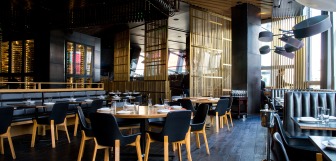Restaurant ROI: What Returns Do Restaurants Bring?
When it comes to marketing, one of the first questions business owners ask is, "what's the return on investment (ROI)?" And rightfully so - no one wants to pour money into a campaign that doesn't produce results. But as a restaurant owner or manager, have you ever stopped to think about what ROI your restaurant brings?
There are a lot of factors that go into a restaurant's ROI. The location, the menu, the atmosphere - all of these things contribute to how much revenue your business generates. So, we're taking a closer look at restaurant ROI and what it really means for your business.
Let's get started.
What is restaurant ROI?
Restaurant ROI, or return on investment, is a metric that businesses use to measure the profitability of their investments. In other words, it's a way to calculate how much money you're making (or losing) from a particular venture.
For restaurants, some common investments that owners may want to track ROI for include:
-
Marketing campaigns: Did your latest ad campaign bring in more customers?
-
New menu items: Did that new dish help increase sales?
-
Restaurant renovations: Was the money you spent on updating your restaurant worth it?
Calculating ROI: how to measure your restaurant’s profit
There are a few different ways to calculate ROI, but the most common formula is as follows:
ROI = (Gain from Investment - Cost of Investment) / Cost of Investment
For example, let's say you spend $1,000 on a marketing campaign for a new Halloween menu. This includes the cost of designing the campaign, creating any promotional materials, and running ads. If this marketing campaign generates $2,000 in additional revenue, your ROI would be:
ROI = ($2,000 - $1,000) / $1,000 = 100%
In other words, you made back your investment plus an additional 100%. Not too shabby!
TIP: Using a restaurant POS software can help you keep track of your sales and ROI as it generates reports on:
-
Menu item sales: How much revenue each menu item is generating
-
Marketing campaigns: How much revenue each marketing campaign brings in
-
Foot traffic: How many customers are coming into your restaurant
-
Total sales: How much revenue your restaurant is generating overall
What is a good restaurant ROI?
There's no one-size-fits-all answer to this question - it really depends on your business goals. For example, if you're a new restaurant trying to build brand awareness, you might be willing to accept a lower restaurant ROI in the short term, knowing that it will pay off in the long run.
On the other hand, if you're an established restaurant with a loyal customer base, you might be more focused on generating immediate results and be less concerned with long-term brand building.
According to CSI Market, the average restaurant ROI in the US in 2022 falls at around 10.73%. MacroTrends also reports an average ROI for quick-service restaurants, or QSR, of about 5% for the 2022 period.
So, if you're not meeting or exceeding these averages, it might be time to reevaluate your restaurant's strategy.

Run the restaurant you've always wanted
Our restaurant POS system has all the features you need to build the restaurant of the future.
- Reduce contact and enhance efficiency with at-table ordering
- Use customizable table plans to improve table turnover
- Sync with leading food delivery apps to reach new customers and boost revenue
- Manage inventory, easily monitor sales and margin performance
- Menu management, employee management and more
Tips for improving restaurant ROI
There are a few things you can do to improve your restaurant ROI percentage:
1. Understand your customers
Who are they, and what do they want? The better you understand your target market, the easier it will be to create marketing campaigns and menu items that appeal to them.
Let's say you're a fast-casual restaurant targeting working professionals in the city. In that case, you might want to focus on creating quick and easy lunch options that your customers can grab on the go. Or, if you're a fine-dining restaurant, you might want to focus on creating an upscale experience with a fixed menu.
A great way to better understand your customers is to carry out market research. This can be as simple as surveying your regular customers or conducting focus groups. Some questions you might want to ask include:
-
What made you choose our restaurant?
-
What do you like/dislike about our restaurant?
-
What is your favorite menu item?
-
What would make you come back more often?
2. Create a strong restaurant marketing strategy
Your restaurant marketing strategy should be designed to reach your target audience and promote your restaurant in the most effective way possible. Your restaurant marketing strategy should include:
-
Your restaurant's USP: What makes your restaurant unique?
-
Your target market: Who are you trying to reach?
-
Your marketing channels: How will you reach your target market?
-
Your restaurant marketing budget: How much are you willing to spend on marketing?
-
Your restaurant marketing goals: What do you hope to achieve with your marketing campaigns?
Want to learn more about creating a restaurant marketing strategy that works? Check out our restaurant social media strategy and digital marketing for restaurants blogs today!
3. Review your menu regularly
Your menu should be reviewed on a regular basis to make sure it's still relevant and appealing to your target market. If you're not sure where to start, consider these questions:
-
Are there any dishes that are no longer selling well?
-
Do any dishes need to be updated or revamped?
-
Are there any gaps in your menu that you could fill with new dishes?
Check out our menu pricing blog for more info.
4. Identify progress methods
As we mentioned earlier, you need to have a clear understanding of your goals before you can launch a marketing campaign. Once you've set your goals, you can identify progress methods or KPIs that will help you measure your success.
Some restaurant KPIs to consider when looking to calculate ROI.
-
Overhead margin: This is the percentage of restaurant sales that is left after subtracting the cost of goods sold (COGS).
-
Gross profit margin: This is the percentage of restaurant sales that is left after subtracting COGS and labor costs.
-
Net profit margin: Your net profit margin is the percentage of restaurant sales that is left after subtracting all expenses, including COGS, labor, and overhead.
-
Historical sales: this is a good metric to track to see if you're on track to reach your goals.
By tracking these KPIs, you can get a better understanding of what's working and what's not and make changes accordingly.
5. Train your staff regularly
Your restaurant staff members are the face of your business, so it's important to make sure they're properly trained and up-to-date on all the latest information. This includes things like your restaurant's history, mission, and values, as well as your menu items and any promotions you might be running.
Regular training will not only help your staff provide better service, but it will also help them better represent your restaurant to customers.
6. Don't neglect your website
Your restaurant website is often the first point of contact between you and potential customers, so it's important to make sure it's in tip-top shape. This means having a well-designed website that's easy to navigate and contains all the potential information customers might be looking for, such as your menu, restaurant location, hours, and contact information.
If you don't have a website, now is the time to create one. And if you do have a website, take some time to review it and make sure it's up-to-date and accurately represents your restaurant.
7. Evaluate your progress regularly
It's important to periodically step back and evaluate your restaurant's progress to see if you're on track to reach your goals. This includes reviewing your KPIs on a regular basis and making changes to your restaurant marketing campaigns and menu items as needed.
By following these tips, you can help ensure that your restaurant is as successful as possible.
8. Innovate and adapt
The restaurant industry is constantly changing, with new restaurant trends and technologies emerging all the time. To stay ahead of the curve, it's important to constantly innovate and adapt your restaurant to keep up with the latest trends.
This might mean something as simple as adding seasonal menu items. Or it could mean something more drastic, like completely overhauling your restaurant's concept or changing your business location.
No matter what, it's important to always think about how you can improve your restaurant and make it more appealing to potential customers.
9. Have realistic expectations
Last but not least, it's important to have realistic expectations when it comes to getting a higher ROI. It's unlikely that you'll see a massive increase overnight, so be patient and focus on making small, incremental changes that will have a big impact over time.
With a little patience and a lot of hard work, you can see a significant increase in your restaurant's ROI. Just remember to focus on your goals, review your progress regularly, and make changes as needed.
Final thoughts
Increasing your restaurant's ROI can be a challenge, but it's not impossible.
Once you learn how to calculate ROI and start implementing tips to improve your restaurant ROIyou'll be well on your way to having running a successful restaurant.
Remember to focus on your goals, review your progress regularly, and make changes as needed. With a little patience and a killer restaurant marketing strategy, you will see a significant increase in your restaurant's ROI.
Not quite at this stage of your startup journey yet? Check out our blog on how to open a restaurant for a complete guide on setting up shop.
Get in touch with our team of experts to see how a Restaurant POS System can help increase your ROI!




